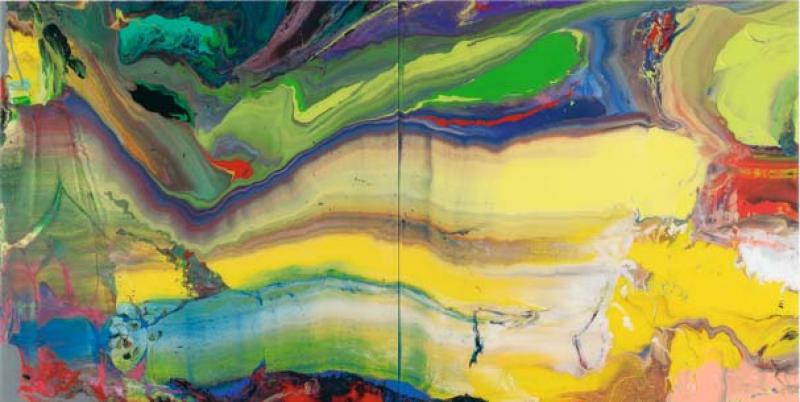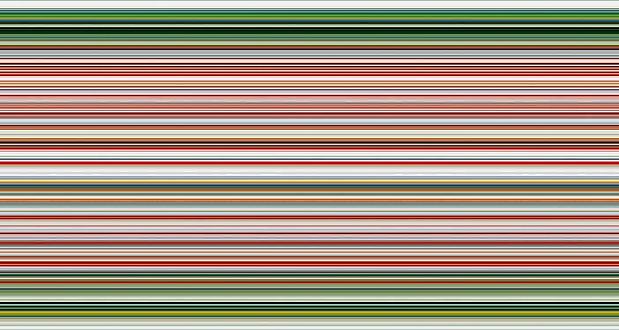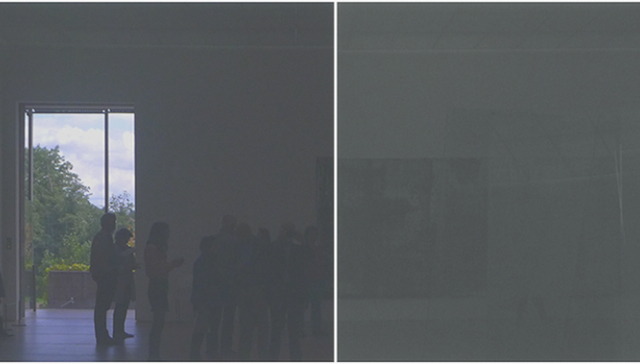Gerhard Richter, Marian Goodman Gallery | reviews, news & interviews
Gerhard Richter, Marian Goodman Gallery
Gerhard Richter, Marian Goodman Gallery
The heavyweight German artist inaugurates prestigious blue-chip gallery in London

Another October and another Frieze week just passed. This means the biggest of big hitters have been turning up in London. The economic quantifiers aren’t precise, but there have been plenty of estimates. Hordes of well-heeled visitors mean big profits for hotels, restaurants, shops and transport.
However cynical some may be – it was after all probably the biggest commercial week for art anywhere – there are real benefits well beyond the economic for art and its viewers. It’s hardly an accident that the biggest of international contemporary galleries have found premises in London since Frieze started in 2002. And more are being added: the Marian Goodman Gallery, the most perspicacious, elegant and original of art shops, has now opened its doors in spectacular fashion.
Richter can both slap you in the face, and beguile you with beauty
Marian Goodman, now a mere 86, is audaciously inaugurated with a bang up-to-date show of one of the most critically and commercially successful artists now extant, the octogenarian Gerhard Richter, whom she has been showing for 30 years. Mrs Goodman, with eponymous galleries in New York and Paris, and officially listing 41 artists she deals with, from Christian Boltanski to William Kentridge, Steve McQueen to Jeff Wall, is now at home in a converted Victorian textile factory, listed Grade II, designed by David Adjaye (deservedly the with-it architect of culture).
And unlike some of the other newly converted galleries and private museums, Goodman is bang in the centre of town, just off Piccadilly Circus. The building provides two floors of spacious galleries, the first floor toplit. The exhibition spaces do achieve that ineffable combination of being both accessible, not too intimidating, and clear – you know where you are – and impressive; spaces that are subliminally, acutely right in some mysterious way.
Richter is an artist who is at times maddeningly opaque. Simultaneously he can provide radiant and memorable imagery that is readily accessible, and he can do these things at the same time.
For the opening show several aspects of Richter’s alchemy are on view. Recent works are made up of hundreds of narrow horizontal stripes of colours that can almost make you dizzy – like Bridget Riley on speed (pictured below: 920-4 Stripe). They are part of a predetermined set of procedures: an elaborate dependence on a painting of 1990, photographed, divided into grids of some 4,000 fragments, digitally processed, and in Richter’s phrase, then “dividing, mirroring, repeating”.
 The results are digitally printed on paper, and shown under Perspex, all of a piece. It’s a combination of technological mechanics, intuition and choice; conceptual art subjected to the rigour of the artist’s eye. Each individual work is called Strip, and numbered. Each is totally different in effect, one from the other. The colours oscillate; the results are both mesmerising and disarmingly beautiful. Are they paintings, drawings, or, works of art in a mechanical age – reproductions? They are something of all of these.
The results are digitally printed on paper, and shown under Perspex, all of a piece. It’s a combination of technological mechanics, intuition and choice; conceptual art subjected to the rigour of the artist’s eye. Each individual work is called Strip, and numbered. Each is totally different in effect, one from the other. The colours oscillate; the results are both mesmerising and disarmingly beautiful. Are they paintings, drawings, or, works of art in a mechanical age – reproductions? They are something of all of these.
Another sequence are the Flow paintings (see main picture), liquid enamel in brilliant colours held in stasis, arrested, paused and fixed onto glass at a point determined by the painter, and then mounted onto aluminium panels. There are also a series of paintings in enamel which are in a variety of greys, dark, shadowy and suggestive, simply titled Gray behind Glass (pictured below). The glass means that you see your own reflection, becoming tantalisingly part of the work. There is a sculpture, too, 7 Scheiben (Kartenhaus), a house of glass slabs leaning against one another, both tipsy and controlled, like a transparent Richard Serra, except you can only look not walk through.
 There are paintings consisting just of squares of colour, simply called 25 Colours. And there is even a series of jeux d’esprit, a series done in the spring of 2009, of exquisite high-definition photographs of what look to be German landscapes: roads, woods, forests, fields, vistas, hills, each sporting a vivid slash of thick oil paint in variegated colours, both obscuring and enhancing the photographic image. The crude fierceness of the oil paint, its peculiar lack of refinement, means somehow that the delicacy of the photographic detail – light on leaves – is thrown into sharp relief.
There are paintings consisting just of squares of colour, simply called 25 Colours. And there is even a series of jeux d’esprit, a series done in the spring of 2009, of exquisite high-definition photographs of what look to be German landscapes: roads, woods, forests, fields, vistas, hills, each sporting a vivid slash of thick oil paint in variegated colours, both obscuring and enhancing the photographic image. The crude fierceness of the oil paint, its peculiar lack of refinement, means somehow that the delicacy of the photographic detail – light on leaves – is thrown into sharp relief.
Richter can both slap you in the face and beguile you with beauty; he is the master of the use of photography, and the exemplar of the hand done. This mass of contradictions fused into his own recognisable idiom is brilliantly displayed in the new galleries, under the unrelenting fluorescent light that the artist demands.
Explore topics
Share this article
The future of Arts Journalism
You can stop theartsdesk.com closing!
We urgently need financing to survive. Our fundraising drive has thus far raised £49,000 but we need to reach £100,000 or we will be forced to close. Please contribute here: https://gofund.me/c3f6033d
And if you can forward this information to anyone who might assist, we’d be grateful.

Subscribe to theartsdesk.com
Thank you for continuing to read our work on theartsdesk.com. For unlimited access to every article in its entirety, including our archive of more than 15,000 pieces, we're asking for £5 per month or £40 per year. We feel it's a very good deal, and hope you do too.
To take a subscription now simply click here.
And if you're looking for that extra gift for a friend or family member, why not treat them to a theartsdesk.com gift subscription?
more Visual arts
 'We are bowled over!' Thank you for your messages of love and support
Much-appreciated words of commendation from readers and the cultural community
'We are bowled over!' Thank you for your messages of love and support
Much-appreciated words of commendation from readers and the cultural community
 Photo Oxford 2025 review - photography all over the town
At last, a UK festival that takes photography seriously
Photo Oxford 2025 review - photography all over the town
At last, a UK festival that takes photography seriously
![SEX MONEY RACE RELIGION [2016] by Gilbert and George. Installation shot of Gilbert & George 21ST CENTURY PICTURES Hayward Gallery](https://theartsdesk.com/sites/default/files/styles/thumbnail/public/mastimages/Gilbert%20%26%20George_%2021ST%20CENTURY%20PICTURES.%20SEX%20MONEY%20RACE%20RELIGION%20%5B2016%5D.%20Photo_%20Mark%20Blower.%20Courtesy%20of%20the%20Gilbert%20%26%20George%20and%20the%20Hayward%20Gallery._0.jpg?itok=7tVsLyR-) Gilbert & George, 21st Century Pictures, Hayward Gallery review - brash, bright and not so beautiful
The couple's coloured photomontages shout louder than ever, causing sensory overload
Gilbert & George, 21st Century Pictures, Hayward Gallery review - brash, bright and not so beautiful
The couple's coloured photomontages shout louder than ever, causing sensory overload
 Lee Miller, Tate Britain review - an extraordinary career that remains an enigma
Fashion photographer, artist or war reporter; will the real Lee Miller please step forward?
Lee Miller, Tate Britain review - an extraordinary career that remains an enigma
Fashion photographer, artist or war reporter; will the real Lee Miller please step forward?
 Kerry James Marshall: The Histories, Royal Academy review - a triumphant celebration of blackness
Room after room of glorious paintings
Kerry James Marshall: The Histories, Royal Academy review - a triumphant celebration of blackness
Room after room of glorious paintings
 Folkestone Triennial 2025 - landscape, seascape, art lovers' escape
Locally rooted festival brings home many but not all global concerns
Folkestone Triennial 2025 - landscape, seascape, art lovers' escape
Locally rooted festival brings home many but not all global concerns
 Sir Brian Clarke (1953-2025) - a personal tribute
Remembering an artist with a gift for the transcendent
Sir Brian Clarke (1953-2025) - a personal tribute
Remembering an artist with a gift for the transcendent
 Emily Kam Kngwarray, Tate Modern review - glimpses of another world
Pictures that are an affirmation of belonging
Emily Kam Kngwarray, Tate Modern review - glimpses of another world
Pictures that are an affirmation of belonging
 Kiefer / Van Gogh, Royal Academy review - a pairing of opposites
Small scale intensity meets large scale melodrama
Kiefer / Van Gogh, Royal Academy review - a pairing of opposites
Small scale intensity meets large scale melodrama
 Jenny Saville: The Anatomy of Painting, National Portrait Gallery review - a protégé losing her way
A brilliant painter in search of a worthwhile subject
Jenny Saville: The Anatomy of Painting, National Portrait Gallery review - a protégé losing her way
A brilliant painter in search of a worthwhile subject
 Abstract Erotic, Courtauld Gallery review - sculpture that is sensuous, funny and subversive
Testing the boundaries of good taste, and winning
Abstract Erotic, Courtauld Gallery review - sculpture that is sensuous, funny and subversive
Testing the boundaries of good taste, and winning
 Edward Burra, Tate Britain review - watercolour made mainstream
Social satire with a nasty bite
Edward Burra, Tate Britain review - watercolour made mainstream
Social satire with a nasty bite

Add comment